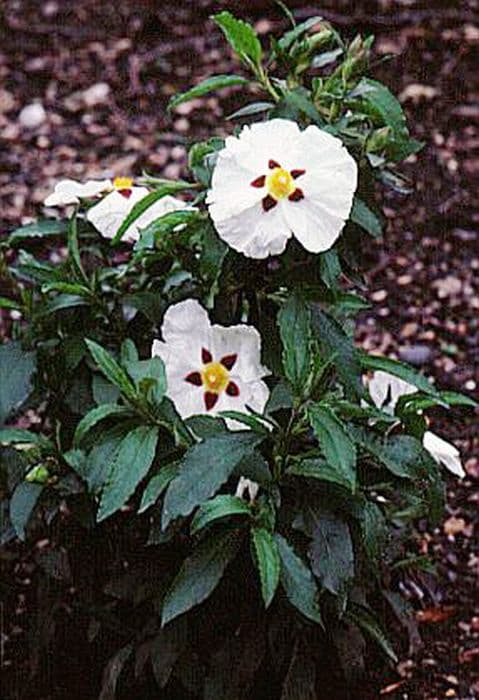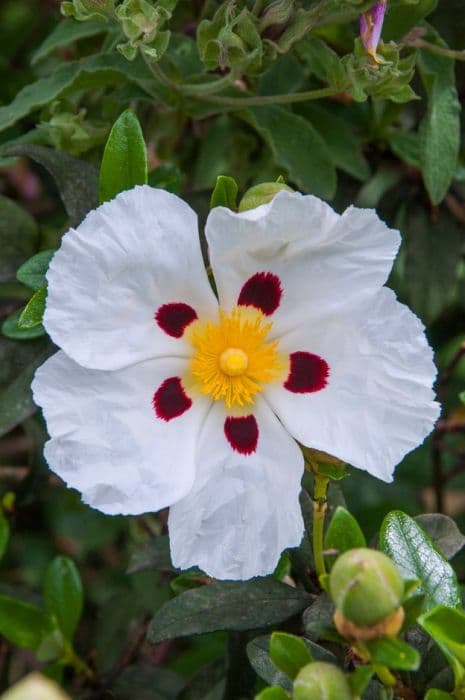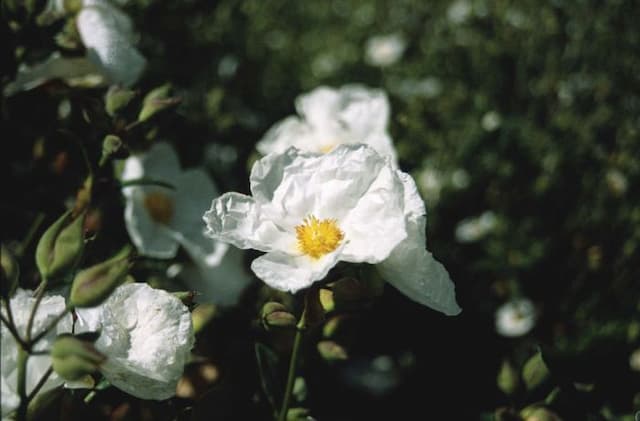Rock Rose Helianthemum 'Georgeham'

ABOUT
Helianthemum 'Georgeham', commonly known as Rock Rose, presents a fascinating array of visual features. This hardy perennial showcases a lush, evergreen foliage that takes on a low, spreading habit. The leaves are small and elliptical, often with a soft, slightly fuzzy texture, which can give the plant a grey-green to blue-green appearance, enhancing its overall allure in a garden setting. Throughout its blooming season, Rock Rose 'Georgeham' becomes dotted with a profusion of flowers. The blooms themselves are particularly eye-catching due to their large, showy petals which range in color from deep, vibrant pinks to soft, delicate shades. Each flower consists of a sunny, open face with a central core of yellow stamens, creating a striking contrast that is highly attractive to pollinators as well as garden admirers. The plant exudes an overall graceful and sturdy presence. Its tendency to spread can create a beautiful, dense mat, making it an excellent ground cover option. The Rock Rose 'Georgeham' is not only a feast for the eyes but also a practical choice for adding texture, color, and a natural, wildflower-like charm to the landscape.
About this plant
 Names
NamesFamily
Cistaceae
Synonyms
Rock Rose, Sunrose
Common names
Helianthemum 'Georgeham'.
 Toxicity
ToxicityTo humans
The Helianthemum 'Georgeham', commonly known as Rock Rose, generally is not known to be toxic to humans. There are no well-documented cases of poisoning from this plant, and it is usually considered safe to have in gardens where humans, including children, are present. Therefore, there are no specific symptoms associated with poisoning from Rock Rose since it is not considered poisonous.
To pets
Similarly to humans, the Helianthemum 'Georgeham' or Rock Rose is not commonly known to be toxic to pets. It is not listed among the potentially poisonous plants for animals such as dogs and cats, and there are no specific symptoms of poisoning reported for pets that ingest this plant. Pet owners can enjoy having Rock Rose in their gardens without significant concern regarding toxicity to their animals.
 Characteristics
CharacteristicsLife cycle
Perennials
Foliage type
Evergreen
Color of leaves
Green
Flower color
Yellow
Height
1 foot (0.3 meters)
Spread
2 feet (0.6 meters)
Plant type
Shrub
Hardiness zones
5
Native area
Mediterranean
Benefits
 General Benefits
General Benefits- Attracts Pollinators: Helianthemum 'Georgeham', commonly known as Rock Rose, is known for attracting bees, butterflies, and other beneficial insects that pollinate flowers.
- Drought Resistance: Rock Rose is particularly resilient in dry conditions, making it suitable for water-wise gardens or regions with low rainfall.
- Low Maintenance: This plant is easy to care for, requiring minimal pruning and upkeep once established in the landscape.
- Landscape Ornamentation: With its bright flowers and evergreen foliage, Rock Rose serves as a vibrant and attractive addition to rock gardens, borders, or ground cover.
- Soil Adaptability: Rock Rose can thrive in a variety of soil types, although it prefers well-drained soils, making it versatile for different garden settings.
- Frost Tolerance: It has a good level of tolerance against frost, allowing it to be a durable perennial in cooler climates.
- Quick Growth: Rock Rose plants generally grow quickly, providing rapid coverage and visual interest in new or barren gardens.
- Long Blooming Period: They have a lengthy blooming season, with flowers that can adorn the garden from spring to summer.
 Medical Properties
Medical PropertiesThis plant is not used for medical purposes.
 Air-purifying Qualities
Air-purifying QualitiesThis plant is not specifically known for air purifying qualities.
 Other Uses
Other Uses- The leaves of the Helianthemum can be used as a natural dye for fabrics, providing a range of colors depending on the mordant used.
- Due to its compact, dense growth, Helianthemum can serve as a living mulch to suppress weeds in garden beds.
- Some people use the stems and flowers of the Helianthemum for creating decorative crafts and dried flower arrangements.
- The Helianthemum can be planted over rockeries and stone walls where its cascading habit adds aesthetic appeal and can help stabilize the soil.
- The plant can be used in sensory gardens, as it has softly textured leaves that provide a tactile experience.
- When planted in large groups, the Helianthemum serves as excellent ground cover to prevent soil erosion on slopes and banks.
- Helianthemum plants can act as a companion plant in gardens to attract beneficial insects that help in the pollination of other plants.
- They can be used in xeriscaping, which is a landscaping technique that reduces the need for irrigation, due to their drought-tolerant nature.
- The Helianthemum's flowers can be pressed and used in the art of flower pressing, creating beautiful and natural art pieces.
- Some gardeners use Helianthemum to edge paths and borders, providing a structured and colorful frame to garden walkways.
Interesting Facts
 Feng Shui
Feng ShuiThe Rock Rose is not used in Feng Shui practice.
 Zodiac Sign Compitability
Zodiac Sign CompitabilityThe Rock Rose is not used in astrology practice.
 Plant Symbolism
Plant Symbolism- Endurance: As a rockrose, the Helianthemum 'Georgeham' symbolizes endurance and resilience, a characteristic trait of the Cistaceae family, known for their ability to thrive in arid, rocky conditions.
- Survival: This plant, like other rockroses, has a remarkable ability to survive in poor soils and harsh sunlight, representing the ability to survive and adapt to challenging environments.
- Beauty in Adversity: Despite growing in difficult circumstances, the Helianthemum 'Georgeham' produces beautiful flowers, symbolizing the idea that beauty and joy can be found even in hard times.
 Water
WaterRock Rose, commonly known as Helianthemum 'Georgeham', requires moderate watering. Allow the top inch of soil to dry out before watering again, which might translate to watering once every one to two weeks depending on local climate conditions and the season. Use between one to two gallons of water each time for an average-sized plant, ensuring even moisture distribution without waterlogging the soil. During the hotter, drier months, you may need to water more frequently, while in the winter, water less often as the plant's growth slows down.
 Light
LightRock Rose thrives best in full sunlight. It should be placed in a location where it can receive at least six hours of direct sunlight daily. The perfect spot for Rock Rose is a south-facing garden or window ledge that is free from shade and well exposed to natural light, which ensures vibrant blooms and healthy growth.
 Temperature
TemperatureRock Rose is able to withstand a broad range of temperatures but prefers a temperate climate. It fares well in USDA hardiness zones 5 through 8, with ideal temperatures ranging between 60 and 80 degrees Fahrenheit. Ensure it is sheltered from temperatures dropping below 50 degrees Fahrenheit to prevent damage, and note that it may not survive if the temperature falls below freezing at roughly 32 degrees Fahrenheit.
 Pruning
PruningPrune Rock Rose to maintain its shape and encourage bushier growth. The best time to prune is early spring, just after the last frost when the plant begins to show new growth. Trim off dead or damaged branches and cut back about a third of the old growth to promote fresh shoots. Pruning is typically needed once a year, but can be done more frequently if the plant becomes too leggy or overgrown.
 Cleaning
CleaningAs needed
 Soil
SoilRock Rose 'Georgeham' thrives in well-draining, gritty soil with a pH between 6.0 and 7.5. Mix equal parts of loamy soil, coarse sand, and peat or compost for optimal conditions.
 Repotting
RepottingRock Rose 'Georgeham' does not need frequent repotting; do it every 2-3 years or when the plant outgrows its container.
 Humidity & Misting
Humidity & MistingRock Rose 'Georgeham' prefers low to moderate humidity levels, aligning with typical household conditions, and does not require high humidity.
 Suitable locations
Suitable locationsIndoor
Provide full light, well-draining soil, and moderate temps.
Outdoor
Plant in full sun, well-draining soil, protect from harsh winter.
Hardiness zone
5-8 USDA
 Life cycle
Life cycleCommonly known as Rock Rose 'Georgeham', this plant begins its life cycle as a seed, germinating in favorable conditions—typically in well-drained soil under full sun. After germination, it enters the vegetative stage, where it grows leaves and stems while establishing a root system. As it matures, it transitions to the flowering stage, typically in late spring or early summer, where it produces its characteristic five-petalled, colorful flowers, attracting pollinators. Following pollination, Rock Rose 'Georgeham' sets seed, completing its reproductive cycle. The seeds may then be dispersed to give rise to new plants, continuing the species' life cycle. Rock Rose 'Georgeham' is a perennial plant, which means it can live for several years, going through the flowering and seeding stages annually.
 Propogation
PropogationPropogation time
Spring-Early Summer
The Helianthemum 'Georgeham', commonly known as the Rock Rose, is often propagated by semi-hardwood cuttings. This method is best done in late summer. Take a cutting of about 4 to 6 inches (10 to 15 centimeters) long from a healthy, non-flowering stem. Strip the lower leaves, and dip the cut end into rooting hormone. Then, insert the cutting into a pot filled with a well-draining soil mix, ensuring at least two nodes are buried where leaves were removed. The cutting should be placed in a warm, bright spot out of direct sunlight and kept moist until roots develop, which typically takes several weeks. Once rooted, the new Rock Rose plant can be gradually acclimatised to outdoor conditions before planting out.









